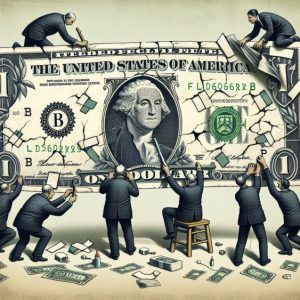
Jan 24, 2024
Introduction
In a world where economic uncertainty is a constant, achieving financial freedom is a goal shared by many but realized by few. Financial freedom, the state where one’s assets generate income surpassing their expenses, is attainable by anyone, regardless of age or income level. This article will guide you through the nine practical steps to financial freedom.
Understand Your Financial Standing
Your journey to financial freedom starts with a simple yet profound understanding of your financial standing. It is akin to a medical check-up, but instead of a doctor, you become the expert diagnosing your financial health, laying the foundation for a solid financial future.
Calculating your net worth is at the heart of understanding your financial standing, a concept as simple as it is profound. Your net worth is the total of your assets, everything you own that has monetary value, subtracted by your liabilities, which is everything you owe. This might sound like a daunting task, but it’s relatively straightforward.
Begin by listing down your assets. These could range from your cash in bank accounts, investments in stocks, bonds, retirement accounts, real estate properties, and even your car and personal belongings that hold value. Try to be as accurate as possible in assigning a value to each asset.
Next, write down your liabilities. This would include every debt you owe, from mortgages, car loans, student loans, and credit card balances to any personal loans. The aim is to ensure every dollar you owe is accounted for.
The difference between your assets and liabilities gives you your net worth. This figure is a financial thermometer, giving you a clear snapshot of your financial health. A positive net worth means your assets exceed your liabilities, where you ultimately want to be. A negative net worth, on the other hand, indicates that you owe more than you own, signalling a need for immediate financial restructuring.
Understanding your net worth is not a one-time exercise but a regular practice, like a financial health check-up. Over time, your assets and liabilities will change. Regularly updating your net worth will help you track your progress towards financial freedom.
More than just numbers on a page, understanding your financial standing is empowering. It reveals the reality of your finances without any sugarcoating. It may be uncomfortable to confront, especially if you discover you have a negative net worth, but remember, this is a starting point, not a final verdict.
Every financial decision, whether spending less on dining out, paying off a credit card, or investing in a mutual fund, impacts your net worth. Understanding your financial standing gives you the control to influence this number, guiding your financial decisions and helping you make informed choices moving forward.
Financial freedom is not a destination but a journey. Understanding your financial standing is the first step on this path. It’s about taking control, making informed decisions, and progressing, one day at a time, towards a future where your financial worries become a thing of the past.
Set Clear Financial Goals
Setting clear, realistic financial goals is a cornerstone of financial freedom. Much like a ship without a compass or financial goals, you risk drifting aimlessly in the ocean of financial possibilities. Your goals serve as your compass, providing direction and helping you chart your course towards financial autonomy.
Financial goals vary from person to person. They could be as ambitious as retiring at 50, as entrepreneurial as starting a business, or as commonplace yet crucial as buying a house or saving for your child’s college education. Regardless, your goals should be SMART – Specific, Measurable, Achievable, Relevant, and Time-bound.
Let’s break down the SMART approach.
‘Specific’ goals are well-defined and unambiguous. Instead of saying, “I want to save more money,” specify how much you want to save. Measurable goals allow you to track your progress. If you aim to keep $10,000 a year, you can measure your progress by how close you are to this figure.
‘Achievable’ is about setting realistic goals. While it’s good to aim high, your goals should be within reach, considering your income and other financial obligations. ‘Relevant’ goals align with your broader financial plan and long-term objectives.
Lastly, ‘Time-bound’ goals have a specific timeline. Setting a deadline creates a sense of urgency and motivates you to stay on track. Instead of saying, “I will pay off my debt,” say, “I will pay off my debt in two years.”
Setting SMART financial goals gives you a clear idea of what you’re working towards and helps you devise a plan to achieve them. It’s about defining what economic success looks like to you and then methodically working towards it.
Remember, achieving financial freedom is not a sprint but a marathon. It calls for patience, discipline, and perseverance. Your financial goals are milestones on this journey, reminding you how far you’ve come and still have to go. As you cross off one goal, you create room for the next, propelling you closer to your vision of financial freedom.
Create a Budget
Creating a budget is like drawing a road map for your financial journey. It’s a tool that helps you navigate income and expenditure, ensuring you never lose your way. A well-planned budget ensures that you’re saving enough, reducing debts, and not overspending, allowing you to steer your financial ship towards the shore of financial freedom.
Think of budgeting as a financial blueprint. It’s a plan that aligns your spending habits with your financial goals. By following this blueprint, you ensure that every dollar you earn has a specific job – covering living expenses, paying off debts, contributing to savings, or being invested for future growth.
The process of creating a budget starts with understanding your income and expenses. List all your sources of income and costs, including rent or mortgage, utilities, groceries, transportation, entertainment, and so on. The goal is to ensure your income covers your expenses with a surplus left for savings and investments.
Once you have a clear idea of your income and expenses, you can allocate your funds effectively. If your expenses exceed your income, look for areas where you can cut back. If you have surplus income, decide how much you want to save or invest.
Creating a budget might seem tedious, but thanks to technology, numerous budgeting tools available online can make this process easier. These tools help you track your income and expenses, set spending limits, and even send alerts when you’re nearing your spending limit.
The beauty of a budget is that it’s flexible. As your financial situation changes, so can your budget. It’s not set in stone but a dynamic tool that evolves with your financial journey.
Remember, a budget is not about restriction but about financial control. It’s about knowing where your money is going and making conscious choices about your spending. It’s a tool that empowers you to take charge of your finances, helping you inch closer to your financial goals and, ultimately, economic freedom.
Eliminate Debt
Debt is often the most formidable enemy standing between you and financial freedom. It’s like a dark cloud casting a shadow over your economic landscape, and eliminating this debt is like letting the sunshine through. It’s vital to prioritize paying off high-interest debts first and then methodically tackle the rest. It’s essential to remember that becoming debt-free is not a Herculean task; it’s a journey that requires discipline, commitment, and a well-devised strategy.
The first step to eliminating debt is understanding it. Understand the type of debts you have, their interest rates, and their due dates. This information is crucial as it helps you plan to tackle your debt.
Next, prioritize your debts. All debts are not created equal. Some are more detrimental to your financial health than others. Credit card debts, payday loans, or any other high-interest debts should be your priority due to their compounding nature. Paying these off first can save you significant money in the long run.
Once you’ve taken care of high-interest debt, move on to other debts like student loans, car loans, or mortgages. While these debts also need attention, their interest rates are generally lower, making them less of a financial burden.
Creating a debt repayment plan is an excellent strategy. This could be the snowball method, where you pay off the smallest debts first to gain momentum, or the avalanche method, where you pay off the highest-interest debts first. Choose a method that suits your financial situation and motivation style.
Remember, while you’re focusing on debt repayment, it’s crucial not to accumulate any more debt. This means living within your means, avoiding unnecessary expenses, and sticking to your budget.
Eliminating debt is like climbing a mountain. It’s challenging, and the journey may seem endless. But with each step you take, each debt you pay off, you’re getting closer to the summit of financial freedom. The view from the top, a life free from the shackles of debt, is worth every sacrifice you make.
Build an Emergency Fund
Building an emergency fund is like constructing a financial safety net. It’s there to catch you when life throws you a curveball, whether it’s an unexpected medical bill, a sudden job loss, or a major car repair. Experts recommend setting aside three to six months of living expenses for a robust emergency fund. This ensures that you have a cushion to land on no matter what life throws at you, preventing a financial fall from derailing your journey towards financial freedom.
An emergency fund is not a luxury; it’s a necessity. It’s the buffer between you and life’s unexpected financial challenges. The lack of an emergency fund often leads to debt accumulation, as credit cards or loans become the go-to solution for unforeseen expenses. Hence, an emergency fund is not just a safety net; it’s a debt prevention tool.
Building an emergency fund is a process. It starts with determining how much you need to save. This is typically three to six months’ worth of expenses, but it could be more depending on your financial situation and comfort level. Include all your essential expenses, such as housing, utilities, groceries, transportation, and healthcare.
Once you know how much you need, start saving. The key is to create, even if it’s a small amount initially. Make it a line item in your budget, just like any other bill. Over time, these small contributions will add up to a substantial emergency fund.
Consider keeping your emergency fund in a separate, easily accessible savings account. This ensures that the money is available when needed, but it’s not too easily accessible to tempt impulsive spending.
Building an emergency fund is like building a financial shield. It protects you from economic uncertainties and gives you peace of mind. Knowing that you have the resources to weather economic storms allows you to sail smoothly towards your financial goals.
Invest Wisely
Investing is a powerful tool in your financial toolbox, and when used wisely, it can transform your economic landscape. The magic of compounding interest and the potential for exponential growth makes investing a critical part of wealth creation. However, investing requires research, understanding, and a thoughtful approach. It’s about choosing investment options that align with your financial goals and risk tolerance and diversifying your portfolio to spread risk and optimize returns.
The first step to wise investing is understanding your investment goals. Are you investing for long-term wealth creation, retirement savings, or a specific goal like buying a house or funding your child’s education? Defining your goals will guide your investment choices and strategy.
Next, assess your risk tolerance. Investing always comes with a degree of risk, and it’s essential to understand your comfort level with this risk. Are you comfortable with the potential for higher returns but higher risk, or do you prefer a more conservative approach? Your risk tolerance will determine the type of investments you choose.
Once you’ve defined your goals and risk tolerance, it’s time to choose your investments. This could involve a mix of stocks, bonds, mutual funds, real estate, or other investment vehicles. The key is to diversify your portfolio. Just as you wouldn’t put all your eggs in one basket, don’t put all your money in one type of investment. Diversification spreads risk across different types of investments, reducing the potential for significant losses.
Investing wisely also means staying informed. Keep abreast of market trends and economic news that might affect your investments. Regularly review your investment portfolio to ensure it remains aligned with your goals and risk tolerance.
Remember, investing is not a get-rich-quick scheme but a long-term strategy for wealth creation. It requires patience, discipline, and a keen understanding of financial markets. Investing wisely allows you to plant the seeds for a prosperous economic future. It’s about ensuring that your money works as hard for you as you do for it, propelling you towards financial freedom.
Protect Your Wealth
Insurance is the umbrella for a rainy day’s journey to financial freedom. It’s a crucial aspect of financial planning, designed to protect your wealth from unforeseen circumstances like health issues, accidents, or property damage. By considering different types of insurance, like health, life, and property, you can customize your coverage to provide the most effective protection based on your needs.
Think of insurance as a shield. It protects your wealth from financial setbacks that could derail your financial plans. An unexpected medical bill, a sudden loss of life, or damage to your property can have significant financial implications. Insurance mitigates these risks, providing you with financial support when you need it most.
Health insurance is a must in today’s world. With rising medical costs, even a minor health issue can result in substantial medical bills. Health insurance covers these costs, protecting your savings from being drained by medical expenses.
Life insurance is essential, especially if you have dependents. It ensures that your loved ones are financially secure during your untimely demise. It’s about providing financial stability for your family, even in your absence.
Property insurance protects your assets from damage or loss, whether for your home or vehicle. Property insurance covers repair or replacement costs, whether it’s a natural disaster, theft, or accident.
Choosing the right insurance requires understanding your needs and risks. Assess your lifestyle, health, assets, and family situation. Consider the potential financial implications of unforeseen events and choose an insurance plan that provides adequate coverage.
Having insurance doesn’t mean anticipating the worst, but it’s about being prepared for it. It’s about protecting your hard-earned wealth from life’s uncertainties. By safeguarding your wealth, you ensure that your journey to financial freedom remains uninterrupted, rain or shine.
Plan for Retirement
Retirement planning is like setting the coordinates for your financial journey into the golden years of life. It’s about ensuring you can maintain your lifestyle, pursue your passions, and live comfortably, even when you stop earning. You can build a substantial retirement nest egg by starting to save early and taking advantage of retirement accounts like 401(k)s and Individual Retirement Accounts (IRAs), which offer tax benefits.
Retirement planning begins with envisioning your retirement. What does your ideal retirement look like? Do you see yourself travelling, pursuing a hobby, or simply living relaxed? Answering these questions will give you an idea of how much you’ll need to save to finance your retirement dreams.
Once you have a clear vision, start saving. The earlier you start, the more time your money has to grow. Thanks to the power of compounding, even small amounts held consistently can accumulate into a significant sum over time.
Retirement accounts like 401(k)s and IRAs are potent tools in your retirement planning arsenal. These accounts offer tax advantages that can significantly boost your savings. A 401(k) allows you to contribute pre-tax dollars, lowering your taxable income. On the other hand, a Roth IRA allows you to withdraw your savings tax-free during retirement.
Diversifying your retirement savings is also crucial. Don’t rely solely on Social Security or a pension. Have multiple retirement income streams, including savings, investments, and perhaps even a part-time job during retirement.
Remember, retirement planning is not a one-time task but a continuous process. Your retirement plan should evolve as your life circumstances, financial situation, and retirement goals change.
Planning for retirement is like building a bridge to your future. It’s about ensuring you can enter your retirement years with financial confidence and security. By planning wisely, you can look forward to a retirement that’s not just financially comfortable but allows you to enjoy the fruits of your hard work fully.
Continuously Educate Yourself
Retirement planning is like setting the coordinates for your financial journey into the golden years of life. It’s about ensuring you can maintain your lifestyle, pursue your passions, and live comfortably, even when you stop earning. You can build a substantial retirement nest egg by starting to save early and taking advantage of retirement accounts like 401(k)s and Individual Retirement Accounts (IRAs), which offer tax benefits.
Retirement planning begins with envisioning your retirement. What does your ideal retirement look like? Do you see yourself travelling, pursuing a hobby, or simply living relaxed? Answering these questions will give you an idea of how much you’ll need to save to finance your retirement dreams.
Once you have a clear vision, start saving. The earlier you start, the more time your money has to grow. Thanks to the power of compounding, even small amounts held consistently can accumulate into a significant sum over time.
Retirement accounts like 401(k)s and IRAs are potent tools in your retirement planning arsenal. These accounts offer tax advantages that can significantly boost your savings. A 401(k) allows you to contribute pre-tax dollars, lowering your taxable income. On the other hand, a Roth IRA allows you to withdraw your savings tax-free during retirement.
Diversifying your retirement savings is also crucial. Don’t rely solely on Social Security or a pension. Have multiple retirement income streams, including savings, investments, and perhaps even a part-time job during retirement.
Remember, retirement planning is not a one-time task but a continuous process. Your retirement plan should evolve as your life circumstances, financial situation, and retirement goals change.
Planning for retirement is like building a bridge to your future. It’s about ensuring you can enter your retirement years with financial confidence and security. By planning wisely, you can look forward to a retirement that’s not just financially comfortable but allows you to enjoy the fruits of your years of hard work fully.
Conclusion
Financial freedom is not a far-fetched dream but a realistic goal that requires planning, discipline, and persistence. By following these nine steps, you secure your financial future and gain the freedom to live on your terms.
Remember, the journey to financial freedom is a marathon, not a sprint. It involves making consistent, wise financial decisions and learning from mistakes. Start today, and step by step, you’ll be closer to your financial freedom.
Satisfy Your Intellect with These Delectable Reads

What Is Mob Mentality? A Symbol of Irrationality

US Dollar Devaluation: How the Fed Legally Robs You

How to Short the Market with Options: Reserved for the Bold and Fearless

The Suave Strategy: How to Buy Gold and Silver for Investment

Which of the Following Investing Statements Is False? Let’s Uncover the Truth!

An Exquisite Approach: How to Buy Gold Without Paying Sales Tax

Extra return generated through market timing strategies is not for risk

How to Buy Gold in Australia: A Captivating Roadmap to Glittering Riches

The Art of Portfolio Agility: Mastering the Tactical Asset Allocation Strategy

Stock Market Forecast for Tomorrow: Ignore Noise, Focus on the Trend

Defying the Crowd: Exploring the Stock Market Fear Index

Crowd Behavior Psychology: Deciphering, Mastery, and Success

Inflation vs Deflation vs Stagflation: Strategies for Triumph

What Is The Best Way For One To Recover After a Financial Disaster?



